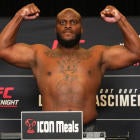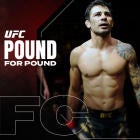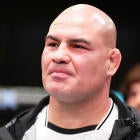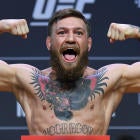It took a bit for UFC 241 to pick up steam, but once it got going, fans were treated to some compelling fights. We have a new heavyweight champion, a threat to the welterweight division after three years of inactivity and a pair of middleweights who might need to run it back after a wild brawl.
Can't get enough UFC? Subscribe to our podcast State of Combat with Brian Campbell where we break down everything you need to know in the Octagon, including a complete recap of UFC 241 below.
Let's take a closer look at what we learned coming out of the UFC 241 event Saturday from Honda Center in Anaheim, California.
1. Stipe Miocic made one of the greatest adjustments in championship history. Miocic and Daniel Cormier seemed well on their way to making it to the judges' scorecards. Both men had landed heavy shots throughout the fight and neither seemed to take much of a step back for the first three rounds.
As the fight hit the championship rounds, something clicked for Miocic and he began digging hard left hands to Cormier's ribs. Punch after punch landed to DC's body and his hands slowly came down to guard against the challenger's attack.
That's when one final Miocic body shot opened the champ up for a follow-up flurry of punches to the head that left Cormier slumped against the cage, Miocic dancing a jig and the UFC with a new heavyweight king.
The kind of adjustment Miocic made is a perfect example of why he is the best heavyweight in the world. And a big reason to think he may hold the belt for a very, very long time.
2. Nate Diaz still doesn't want lame fights. Diaz had no business looking as sharp as he did against Anthony Pettis in the co-headliner. He'd been out of the cage for three years, seemingly uninterested in any fight except the very few that were on his wish list.
A return from that type of layoff against a quick, dynamic fighter like Pettis is usually the last thing a fighter would want. But Diaz isn't a normal fighter, and a fight with someone like Pettis is exactly what got Diaz interested in returning to the Octagon. After all, Diaz said he was looking to avoid the "lame" fighters who'd taken over the sport in recent years.
Diaz, who became a transcendent personality and fighter with his win (and subsequent close decision loss) against Conor McGregor in 2016, could be positioning himself for a shot at the welterweight title after impressively battering Pettis for three rounds. His name value is high and beating Pettis was legit. Instead, he wants a fight with Jorge Masvidal because "there ain't no gangsters in this game anymore. There ain't nobody to ride but me and him."
I'm not surprised…
3. Paulo Costa is legit … but so is Yoel Romero. It may take a re-watch to confirm, but the gut feeling after the final bell in the middleweight scrap between Yoel Romero and Paulo Costa was that Romero had handed his younger opponent his first pro loss. The live crowd reaction following the announcement of three 29-28 scorecards for Costa was heavily composed of boos, but neither man should feel down after their wild brawl.
Costa came out hard and landed several shots that would have ended the night for the majority of the UFC's middleweight roster. The same can be said for Romero. But it was Romero's composure and endurance that helped him win more and more exchanges in the second half of the fight.
Costa entered the night ranked No. 7 in the division, Romero No. 2. Despite the result, it would be entirely valid to see Romero remain the higher ranked fighter as Costa shuffles upward.
Maybe a five-round main event rematch down the road would sort things out between the two.
4. If Derek Brunson is a gatekeeper, he's going to keep a hell of a gate. Ian Heinisch entered his middleweight clash with Derek Brunson as the favorite. Heinisch was the new model at 185 while Brunson was on his way out -- or at least that was the storyline.
Instead, where Brunson used to burn hot for one round in an all-or-nothing effort, he showed patience and thoughtfulness in his approach to the fight. Heinisch was the one who burned out after early efforts, allowing Brunson 2.0 to slowly turn up the pressure, take over the fight and earn a clear-cut decision victory.
Brunson has always had the physical tools to be a force at 185 pounds, but he lacked the discipline to reach what many people saw as his true potential. If he's made the adjustment, Brunson has a lot of life left in the Octagon.
5. Don't sleep on all big underdogs. Khama Worthy had all the signs of a guy who would be one-and-done in the UFC. He was brought into the promotion on less than one-week's notice, had suffered numerous stoppage losses in his career, fought just three weeks prior to his Octagon debut against Devonte Smith and his nickname was "The Deathstar," something notorious in film for blowing up in a moment of crushing defeat.
These are all valid reasons to look at his +600 line at the betting window and think he's one dog worth avoiding.
But Worthy had some factors that should have been red flags for fans of Smith. The men were former training partners, so Worthy's lack of a camp was not lack of knowledge of his opponent. He'd also picked up 11 stoppage victories in his career, so he had the tools to do exactly what he did and catch Smith over-extending on a strike.
There's no reason to bet on every massive underdog in a UFC fight, but Worthy gave fans a reminder to dig a little deeper on unfamiliar names making short-notice debuts.





















